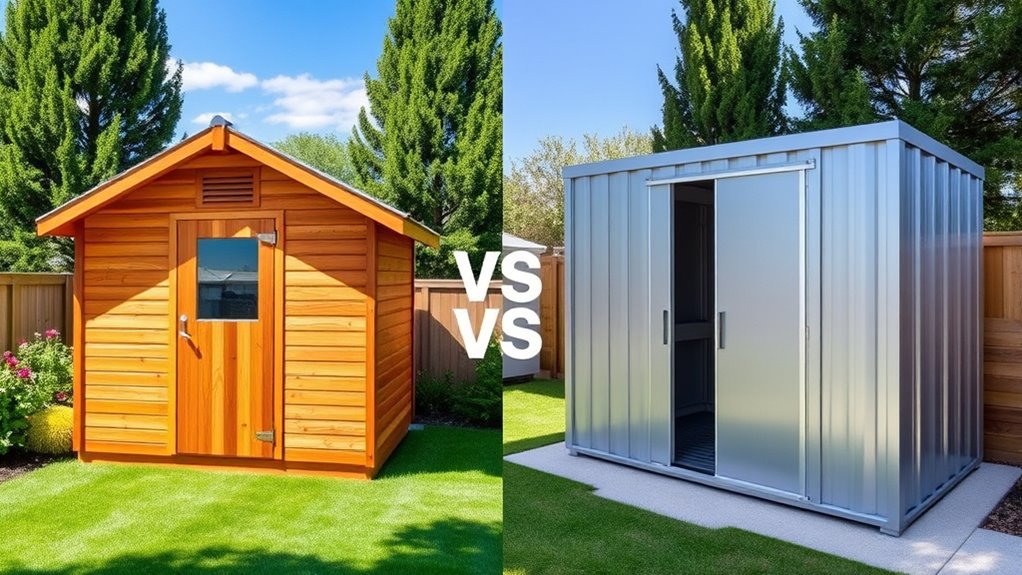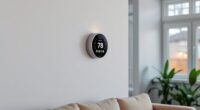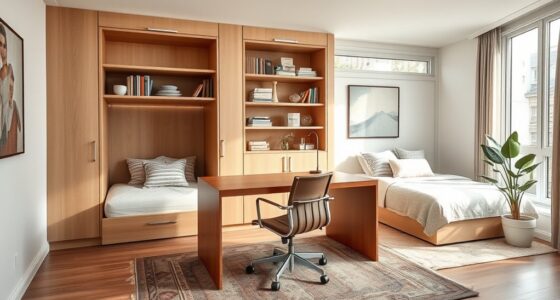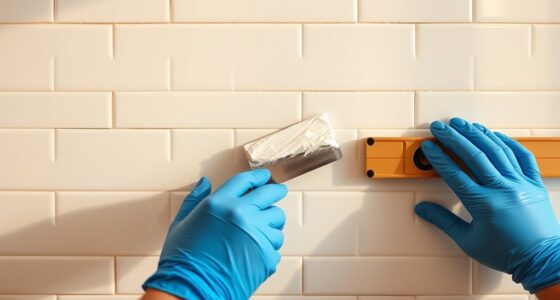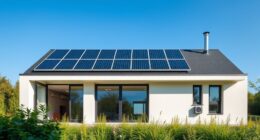Deciding whether to build or buy a storage shed depends on your budget, timeline, and customization needs. Building your own shed can save money and allow full control over design, but it takes time and effort. Buying a pre-made shed offers quick setup and professional quality, with less hassle. Consider what fits best with your skills and priorities, and you’ll find the right choice. Keep exploring to discover which option suits your needs better.
Key Takeaways
- Building offers customization but requires time, effort, and DIY skills, while buying provides quick, professional installation.
- Material choices impact costs, durability, and maintenance; pre-built sheds often come with warranties reducing long-term expenses.
- Larger or complex sheds increase costs regardless of building or buying, so consider your budget and needs.
- Building allows full control over design features, whereas pre-made sheds limit style and size options.
- For immediate use and convenience, buying a shed is preferable; building suits those seeking tailored solutions and enjoy DIY projects.
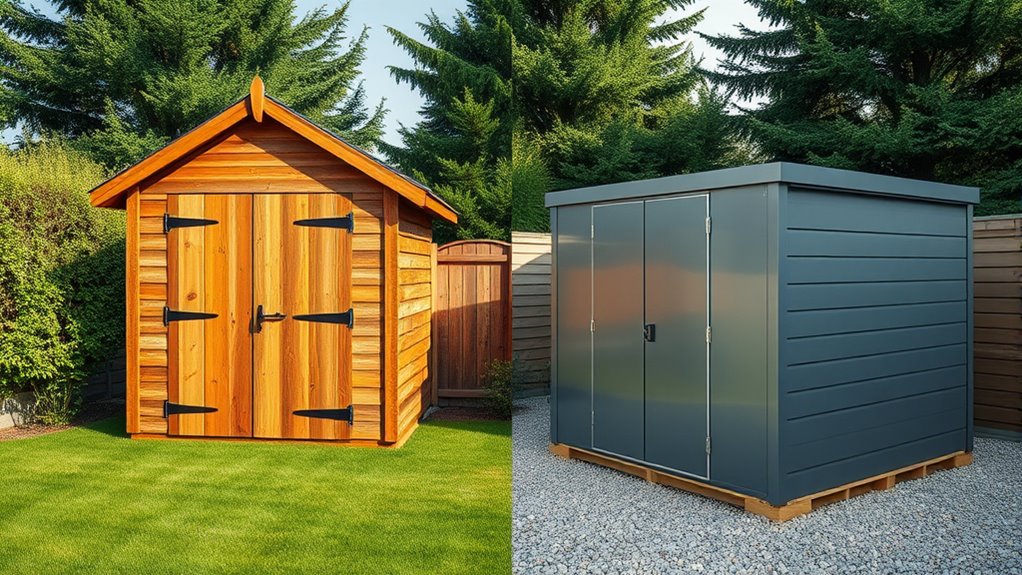
When deciding whether to build or buy a storage shed, you should consider factors like cost, time, customization, and long-term maintenance. Building a shed typically requires a lower initial investment since you can save on labor costs, especially if you’re comfortable with DIY projects. The main expense comes from purchasing quality materials such as wood, metal, or vinyl, which vary in price depending on your choices. Although building might seem cheaper upfront, buying a pre-built shed can offer long-term savings through warranties and professional craftsmanship that reduce maintenance worries. Customization plays a big role here; building allows you to tailor the design, size, and features to your exact needs and property style, but this can also increase costs if you add special features like windows or electrical wiring. Larger or more complex sheds naturally cost more, whether you’re building or buying, due to the increased materials and effort involved.
Time is another critical factor. Constructing a shed can take days or even weeks, depending on your skill level and the shed’s complexity. If you need a shed quickly, buying a pre-made unit that’s ready for delivery and professional installation can save you significant time. This convenience means you can start using your shed almost immediately, whereas building requires planning, effort, and potentially hiring help or enlisting friends. If you lack DIY skills, buying might be the smarter, less stressful option, while building can become a labor-intensive project that demands physical effort and time commitment.
Design flexibility is another advantage of building. You can choose materials, size, and features to match your specific needs and aesthetic preferences, creating a shed that seamlessly integrates with your property. Both building and buying offer options for adding windows or electrical wiring, but building gives you more control over unique design elements. Proper placement and design can boost your property’s curb appeal, enhancing resale potential. While pre-built sheds come in standard sizes and styles, building allows for precise customization, ensuring your shed meets both functional and visual goals.
Durability and maintenance are crucial considerations. Wood sheds are sturdy but may require more upkeep over time, while metal sheds resist insects and pests but could rust if not properly treated. Pre-built sheds often come with warranties and customer support, reducing some long-term maintenance concerns. Regardless of your choice, regular upkeep is essential for longevity. Materials like metal are fire-resistant and insect-proof, which can be important depending on your environment. Furthermore, modern manufacturing techniques ensure sheds are designed to withstand harsh weather conditions, adding to their durability. Ultimately, whether you build or buy, choosing a shed that matches your needs, budget, and style can positively impact your property’s value and usability for years to come.
Frequently Asked Questions
What Are the Long-Term Maintenance Costs for DIY Sheds?
You’ll face ongoing maintenance costs with DIY sheds, including regular painting or staining every 3-5 years for wood, pest treatments, and occasional repairs costing around $2,600 to $3,500. Metal sheds need rust treatments, vinyl sheds require minimal cleaning, and roof replacements happen every 10-15 years. If you add electrical or upgrades, expect higher costs. DIY repairs save money but demand time and skills, impacting your long-term budget.
How Do Building Codes Affect Custom Shed Construction?
Building codes create a roadmap for your custom shed, balancing safety with creativity. They dictate materials, size, and placement, forcing you to adapt your design to local regulations. While they may seem restrictive, these codes guarantee your shed’s durability and safety. You’ll need permits, detailed plans, and inspections, which can delay your project but ultimately protect your investment and peace of mind, making your shed both compliant and sturdy.
Are There Eco-Friendly Storage Shed Options Available?
You’ll find plenty of eco-friendly storage shed options available today. You can choose from resin, metal, or reclaimed wood sheds, all designed with sustainability in mind. These materials are durable, require less maintenance, and have a smaller carbon footprint. Plus, incorporating natural insulation, reflective barriers, and natural ventilation boosts energy efficiency. Opting for eco-friendly sheds helps you reduce environmental impact while providing a long-lasting, sustainable storage solution.
Can I Add Electrical Wiring to a Prefabricated Shed?
They say “look before you leap,” and that’s true when adding electrical wiring to a prefabricated shed. You can definitely do it, but you must follow local codes and obtain permits. Plan your power source, use the right materials, and hire a licensed electrician if needed. Proper wiring, grounding, and safety features guarantee your shed is functional and safe, turning it into a versatile, powered workspace or storage area.
What Are the Warranty Differences Between Built and Bought Sheds?
When comparing warranties, bought sheds usually come with manufacturer coverage that protects you against defects in materials and craftsmanship, often for 1-2 years or even a lifetime. Built sheds, on the other hand, generally lack formal warranties, leaving you responsible for repairs and quality issues. This means that with a purchased shed, you get peace of mind and support, while DIY sheds rely on your skills and the quality of your materials.
Conclusion
So, whether you choose to build or buy, remember that your decision shapes your space and your story. Building offers customization, like painting a blank canvas, while buying provides convenience, like opening a ready-made gift. Both paths have their merits, but it’s your needs and timing that truly matter. In the end, it’s not just about shelter—it’s about creating a space that reflects your lifestyle and priorities, making your yard uniquely yours.
